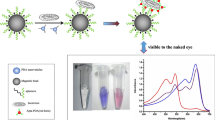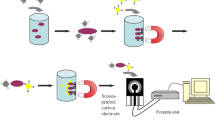Abstract
The development of a label-free impedimetric aptasensor is reported for rapid and sensitive detection of Escherichia coli O157:H7 employing boron-carbon nanorods decorated by nickel nanoparticles (BC-Ni) nanostructured platform. These highly electroactive BC-Ni nanorods were synthesized to increase the sensitivity of the sensor surface and subsequently functionalized with a specific anti-E. coli O157:H7 aptamer (Kd = 69 nM) as bio-recognition moiety. This fully characterized high-affinity DNA aptamer against the bacteria was selected using a facile microtiter plate-based cell-SELEX methodology. The fabricated electrochemical aptasensor is demonstrated to detect E. coli O157:H7 selectively with a detection limit of 10 cfu and a dynamic detection range of 100 to 105 cfu in water, juice, and fecal samples.

Graphical abstract






Similar content being viewed by others
References
Saxena T, Kaushik P, Krishna Mohan M (2015) Prevalence of E. coli O157: H7 in water sources: an overview on associated diseases, outbreaks and detection methods. Diagn Microbiol Infect Dis 82:249–264. https://doi.org/10.1016/j.diagmicrobio.2015.03.015
WHO (2015) Estimates of the global burden of foodborne diseases 2007–2015. 09–265
WHO (2019) WHO | diseases and risks. World Health Organization
Parsons BD, Zelyas N, Berenger BM, Chui L (2016) Detection, characterization, and typing of Shiga toxin-producing Escherichia coli. Front Microbiol 7:478. https://doi.org/10.3389/fmicb.2016.00478
Mateo-Sagasta J, Marjani S, Turral H, Burke J (2017) Water pollution from agriculture: a global review. FAO y IWMI 35. http://www.fao.org/3/a-i7754e.pdf
Croxen MA, Finlay BB (2010) Molecular mechanisms of Escherichia coli pathogenicity. Nat Rev Microbiol 8:26–38. https://doi.org/10.1038/nrmicro2265
Haugum K, Brandal LT, Lindstedt B-A, Wester AL, Bergh K, Afset JE (2014) PCR-based detection and molecular characterization of Shiga toxin-producing Escherichia coli strains in a routine microbiology laboratory over 16 years. J Clin Microbiol 52:3156–3163. https://doi.org/10.1128/JCM.00453-14
Sefah K, Shangguan D, Xiong X, O'Donoghue MB, Tan W (2010) Development of DNA aptamers using cell-SELEX. Nat Protoc 5:1169–1185. https://doi.org/10.1038/nprot.2010.66
Kumar V, Shorie M, Ganguli AK, Sabherwal P (2015) Graphene-CNT nanohybrid aptasensor for label free detection of cardiac biomarker myoglobin. Biosens Bioelectron 72:56–60. https://doi.org/10.1016/J.BIOS.2015.04.089
Priyanka SM, Bhalla V, Pathania P, Suri CR (2014) Nanobioprobe mediated DNA aptamers for explosive detection. Chem Commun 50:1080. https://doi.org/10.1039/c3cc47562j
Iijima S (1991) Helical microtubules of graphitic carbon. Nature 354:56–58. https://doi.org/10.1038/354056a0
Ma F, Wang M, Shao Y, Wang L, Wu Y, Wang Z, Hao X (2017) “Thermal substitution” for preparing ternary BCN nanosheets with enhanced and controllable nonlinear optical performance. J Mater Chem C 5:2559–2565. https://doi.org/10.1039/c7tc00131b
Thaweesak S, Wang S, Lyu M, Xiao M, Peerakiatkhajohn P, Wang L (2017) Boron-doped graphitic carbon nitride nanosheets for enhanced visible light photocatalytic water splitting. Dalt Trans 46:10714–10720. https://doi.org/10.1039/c7dt00933j
Panchakarla LS, Govindaraj A, Rao CNR (2007) Nitrogen- and boron-doped double- walled carbon nanotubes. ACS Nano 1:494–500. https://doi.org/10.1021/nn700230n
Cardoso WS, Dias VLN, Costa WM, De Araujo RI, Marques EP, Sousa AG, Boaventura J, Bezerra CWB, Song C, Liu H, Zhang J, Marques ALB (2009) Nickel-dimethylglyoxime complex modified graphite and carbon paste electrodes: preparation and catalytic activity towards methanol/ethanol oxidation. J Appl Electrochem 39:55–64. https://doi.org/10.1007/s10800-008-9636-x
Ben MN, Najeh I, Mansouri S, El Mir L (2015) Effect of pyrolysis temperature on the properties of carbon/nickel nanocomposites prepared by sol–gel method. Appl Surf Sci 337:158–165. https://doi.org/10.1016/j.apsusc.2015.02.084
Jabbar A, Yasin G, Khan WQ, Anwar MY, Korai RM, Nizam MN, Muhyodin G (2017) Electrochemical deposition of nickel graphene composite coatings: effect of deposition temperature on its surface morphology and corrosion resistance. RSC Adv 7:31100–31109. https://doi.org/10.1039/C6RA28755G
Kaur H, Shorie M, Sharma M, Ganguli AK, Sabherwal P (2017) Bridged Rebar Graphene functionalized aptasensor for pathogenic E. coli O78:K80:H11 detection. Biosens Bioelectron 98:486–493. https://doi.org/10.1016/j.bios.2017.07.004
Panchakarla LS, Govindaraj A, Rao CNR (2010) Boron- and nitrogen-doped carbon nanotubes and graphene. Inorganica Chim Acta 363:4163–4174. https://doi.org/10.1016/j.ica.2010.07.057
Li L, Yang H, Yang J, Zhang L, Miao J, Zhang Y, Sun C, Huang W, Dong X, Liu B (2016) Hierarchical carbon@Ni 3 S 2 @MoS 2 double core–shell nanorods for high-performance supercapacitors. J Mater Chem A 4:1319–1325. https://doi.org/10.1039/C5TA08714G
Gu H, Duan N, Wu S, Hao L, Xia Y, Ma X, Wang Z (2016) Graphene oxide-assisted non-immobilized SELEX of okdaic acid aptamer and the analytical application of aptasensor. Sci Rep 6. https://doi.org/10.1038/srep21665
Gu MB, Kim HS (2014) Biosensors based on aptamers and enzymes. Adv Biochem Eng Biotechnol 140. https://doi.org/10.1007/978-3-642-54143-8
Liu B, Liu LR, Liu XJ, Liu MJ, Xiao YS (2012) Variation of crystal structure in nickel nanoparticles filled in carbon nanotubes. Mater Sci Technol 28:1345–1348. https://doi.org/10.1179/1743284712Y.0000000085
Ferrari A, Robertson J (2000) Interpretation of Raman spectra of disordered and amorphous carbon. Phys Rev B - Condens Matter Mater Phys 61:14095–14107. https://doi.org/10.1103/PhysRevB.61.14095
Palomäki T, Peltola E, Sainio S, Wester N, Pitkänen O, Kordas K, Koskinen J, Laurila T (2018) Unmodified and multiwalled carbon nanotube modified tetrahedral amorphous carbon (ta-C) films as in vivo sensor materials for sensitive and selective detection of dopamine. Biosens Bioelectron 118:23–30. https://doi.org/10.1016/j.bios.2018.07.018
Ferrari AC (2007) Raman spectroscopy of graphene and graphite: disorder, electron–phonon coupling, doping and nonadiabatic effects. Solid State Commun 143:47–57. https://doi.org/10.1016/j.ssc.2007.03.052
Arunkumar S, Jegatheesh V, Soundharya R, Jesy Alka M, Mayavan S (2018) BCN based oil coatings for mild steel under aggressive chloride ion environment. Appl Surf Sci 449:287–294. https://doi.org/10.1016/j.apsusc.2018.01.030
Sing KSW (1985) Reporting physisorption data for gas/solid systems with special reference to the determination of surface area and porosity (recommendations 1984). Pure Appl Chem 57:603–619. https://doi.org/10.1351/pac198557040603
Wang Q, Zhao Y, Yang Q, Du D, Yang H, Lin Y (2019) Amperometric sarcosine biosensor with strong anti-interference capabilities based on mesoporous organic-inorganic hybrid materials. Biosens Bioelectron 141:111431. https://doi.org/10.1016/j.bios.2019.111431
Tomer VK, Singh K, Kaur H, Shorie M, Sabherwal P (2017) Rapid acetone detection using indium loaded WO3/SnO2 nanohybrid sensor. Sensors Actuators B Chem 253:703–713. https://doi.org/10.1016/j.snb.2017.06.179
Kumar V, Brent JR, Shorie M, Kaur H, Chadha G, Thomas AG, Lewis EA, Rooney AP, Nguyen L, Zhong XL, Burke MG, Haigh SJ, Walton A, McNaughter PD, Tedstone AA, Savjani N, Muryn CA, O'Brien P, Ganguli AK, Lewis DJ, Sabherwal P (2016) Nanostructured aptamer-functionalized black phosphorus sensing platform for label-free detection of myoglobin, a cardiovascular disease biomarker. ACS Appl Mater Interfaces 8:22860–22868. https://doi.org/10.1021/acsami.6b06488
Vinogradov E, Conlan JW, Perry MB (2000) Serological cross-reaction between the lipopolysaccharide O-polysaccharide antigens of Escherichia coli O157:H7 and strains of Citrobacter freundii and Citrobacter sedlakii. FEMS Microbiol Lett 190:157–161. https://doi.org/10.1111/j.1574-6968.2000.tb09279.x
Nishiuchi Y, Doe M, Hotta H, Kobayashi K (2000) Structure and serologic properties of O-specific polysaccharide from Citrobacter freundii possessing cross-reactivity with Escherichia coli O157:H7. FEMS Immunol Med Microbiol 28:163–171. https://doi.org/10.1111/j.1574-695x.2000.tb01472.x
Acknowledgments
The authors acknowledge Dr. Sharmistha Sinha from INST, Mohali, for providing laboratory facilities and resources for experimental studies.
Funding
The authors acknowledge DST Nanomission Project (No. SR/NM/NS-1510/2014-G) for financial funding. HK and MS acknowledge INST-PhD and CSIR-JRF for fellowships.
Author information
Authors and Affiliations
Corresponding author
Ethics declarations
Conflict of interest
The authors declare that they have no competing interests.
Additional information
Publisher’s note
Springer Nature remains neutral with regard to jurisdictional claims in published maps and institutional affiliations.
Electronic supplementary material
ESM 1
(DOCX 3642 kb)
Rights and permissions
About this article
Cite this article
Kaur, H., Shorie, M. & Sabherwal, P. Electrochemical aptasensor using boron-carbon nanorods decorated by nickel nanoparticles for detection of E. coli O157:H7. Microchim Acta 187, 461 (2020). https://doi.org/10.1007/s00604-020-04444-y
Received:
Accepted:
Published:
DOI: https://doi.org/10.1007/s00604-020-04444-y




